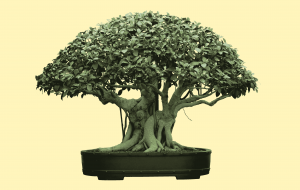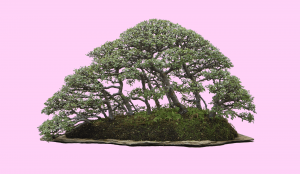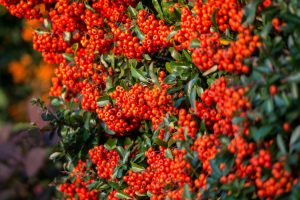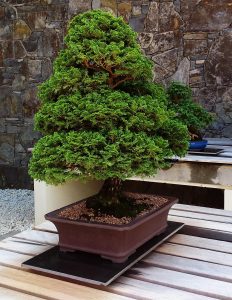
Ficus with aerial roots bonsai tree

Forest planting bonsai
Bonsai Trees are a living artform that you can enjoy
The art of Bonsai captures the appearance of ancient, weathered trees in a small size. Probably, the first trees were dug up and taken down from high altitude sites in the mountains, and put into pots to enjoy in the home. Trimming of the foliage and roots induces the plant to grow its trunk larger. Pruning removes the branches that time and weathering naturally select to eliminate.
I break this down in a way that gives you a more simple view of how they are made and what you need to create or maintain & improve a bonsai tree. If you are new to this artform… take the time to consider whether you want outdoor or tropical plant material (or both). Some plants need to go through the cold season or they die. Those are considered outdoor material. You can just plant them in your yard for the winter.
Outdoor plant? Don’t worry!
If you live in a climate where the cold season gets too cold for the plant that you love…don’t worry…you can leave it in the changing weather until it safely goes dormant. Then store it someplace sheltered and cool with low light until Spring. In the dormant state, you water them less. This location could be an unheated garage with windows or a cold frame. Leaves will change color, but may take quite a while to die and drop from the plant.
The thing that you need to really remember when you do this, however, is that a potted plant is far more vulnerable to cold. You don’t want to leave your potted plant outside in freezing temperatures that can freeze the roots and kill it. Adapt accordingly for a plant in a pot. If they are in the ground, they are more protected. You can cover the base with mulch or put a cover over the entire plant when the temperatures drop.
Indoor plants
You can also take your tropicals in to be indoor plants in your house during the winter season and help them avoid cold weather altogether. This additional greenery is uplifting in wintertime, but you may not want to overcrowd your living space with these plants…like I do.
In this case, you may want to consider getting grow lights for your plants. They can be put on a timer to keep things simple. It is up to you what type of bulbs you want to use, but be sure not to place lights that get hot close to your plants. That will very likely damage them.
First I will show you some of the professionally started trees… then I will give you a feel for how to create your own tree “from scratch”
I wanted to have a bonsai tree “someday”. Then I had a friend who had the same interest, who pushed me to just jump in and start. It does seem intimidating… until you understand the basics. I would like to help you to see what you need to jump in and get started. My wish is to take down barriers for you that may be holding you back… Start where you like… find the tools to learn more as you go.
Start in what ever way you want
I think that once you look through this list, you can get an idea of basic and additional bonsai resources and their cost. You will see that it is not really an expensive hobby. I have found the core, quality items that are also reasonably priced. You can get a great start with the items here. These are resources that even the experienced bonsai artist will appreciate.
These are very affordable trees – both professionally started and material for you to start your own
I have chosen well established trees…these are the most attractive for the price that you will find in each plant material category
You can find cheaper versions…but these are the trees that have been trained by professionals for many years and are truly great specimens. These are worth buying for any enthusiast from beginner to advanced. They will be healthy trees that survive transport stress easily. These are not just a small plant placed in a bonsai pot. You will not be disappointed by the appearance or hardiness of these trees.
Brussel’s Nursery is a bonsai resource supplier that has a well-known, great reputation. You can get younger and cheaper plant material and style them to what you want yourself…these can be great examples to inspire you in doing that. This is the tree that you admire and look at every day and strive towards in your own work… Any level experience artist will be very happy with what they are when they first arrive on your doorstep.
Juniper tree with pond area included in the pot – 3 years, 7″ glazed pot.
Broom style (Hokidachi) tree, but excellent material for building into another style you may like. What makes this one particularly attractive and special is that it has this pond area included in the pot that makes it more fun. When and if your tree outgrows this pot, you can start another one of your own creation in this unique and attractive environment.
Well established Green Mound Juniper (Juniperus procumbens ‘Nana’) – 3 years, 4″ to 6″ tall.
The Green Mound Juniper is the best pine category material for the beginning artist to make a fast bonsai for themselves. It truly is a mound of greenery to trim to what you want. This was done by a professional and grown into a healthy tree over many years.
Hawaiian Umbrella (Schefflera aboricola ‘Luseane’) Tree from Brussel’s – 8 years and about 15″.
It is broom style (Hokidachi). This tree can easily grow aerial roots (roots from branches to the ground) with use of a humidity tent. Many of these have wonderful aerial roots already.
Chinese Elm from Brussel’s – 5 years and about 9″ tall.
This is an Informal Upright bonsai (Moyogi), and a very attractive traditional tree variety.
Golden Gate Ficus from Brussel’s – 4 years old and about 9″ tall.
An Informal Upright style (Moyogi) that can easily grow aerial roots (roots from branches to the ground) with use of a humidity tent.
Golden Gate Ficus from Brussel’s – 7 years old and about 13″ tall.
This tree is Informal Upright style (Moyogi) and can easily grow aerial roots (roots from branches to the ground) with use of a humidity tent.
Gensing grafted or Elephant foot ficus (Ficus microcarpa ‘Gensing’) – 16 years, 16″ tall.
The Elephant foot ficus have very unique looking and massive roots (which inspire the Elephant foot name). Being a ficus, they are very hardy and easy care material in the tropical plant category. You can grow aerial roots with the use of a humidity tent.
Flowering bonsai
These are the plants that will have beautiful showy flowers as well…what’s not to love? Most come as broom style tree because that maximizes the flower volume of the plant. You can change this to many other styles if you desire.
SERISSA NOTE: If you are looking at Serissa bonsai, let me warn you that they can be very difficult. This bush has shiny, dark, small leaves and grows very dense foliage easily. Serissa come in many flower styles, the multiple layer flowers look just like teeny tiny white roses. They are incredibly beautiful and truly irresistible. I have never done well with them and have seen them ruin bonsai for many people. They are not easy to keep alive for most of us.
If you decide Serrisa are a plant that you want, keep this in mind. Please do not make this your only tree, or let yourself be discouraged if it dies. I do not have them in this list and I highly recommend the Fukien Tea as the better alternative to this material.
Fukien Tea (also called Fujian Tea) – 6 years, 11″ tall.
This is the classic indoor bonsai material. It is extremely popular for the Upright Informal style like this one. They will have tiny white flowers and the leaves have a wonderful texture and some get an interesting trilobe tip. The best part is that they are very hardy and easy care.
Satzuki Azalea – 6 years, 8″ to 10″ tall, colorful flowers.
This is the Japanese plant that is a traditional and cherished material for these trees.
If you get an Azalea, I recommend the acid fertilizer for bringing out it’s best.
Gardenia bonsai – 4 years, 6″ to 8″ tall
Pyracantha or Firethorn “Red Cushion”- Plant in 4″ pot… not styled
This is material that is thorny, but it is extremely popular bonsai material for good reason. These bushes grow in a mound shape that will be easy to shape in the bonsai style that you desire. The plant will have many small white flowers, followed by particularly showy red berries that give it this name. You will want to have this plant outside for pollination by insects in order to get these spectacular berries.

Firethorn bush berries are very striking
This section is plant material for the person who is a beginner who wants to start that tree themselves! (Good for you!)
There is a ficus variety called Benjamina ficus or Weeping fig. These are easily found at any garden center or even sometimes office supply places. They are just OUTSTANDING tropical material for beginning bonsai. Ficus are flexible, hardy, fast growing, and can be easily encouraged to grow aerial roots or recover from a shock with a humidity tent.
The other great material to start out is the Green Mound Juniper. Truly a mound of foliage that is soft needle and very hardy. Since they are used as landscaping material, they are fairly easy to come by. They are not expensive either, so you can get one and style it into any style type you like. If you don’t like the results, just get another and try again. Hey, just try out any plant material that can get a woody base.
Wiandi ficus
The standout in the Benjamina ficus group is the Wiandi. It has naturally curvy growth habit that is a show stopper. You can easily style a gorgeous bonsai with this plant. It will grow fast and become a stunning tree in time… not even a long amount of time. Sadly, the one on Amazon is ridiculously priced and already styled by someone. Keep your eye out for this ficus variety. I stumbled upon these at a huge garden center and fell in love instantly.
Benjamina varieties
This ficus is also called a Weeping ficus/fig and is very easy to find! They are in office supply plants and in garden centers. A plant that is flexible, hardy and fast-growing. First is in 1 gallon pot & variegated leaves, Second is 6″ pot & solid leaves, Third is 4″ pot ficus plants & variegated leaves
Green Island Ficus
These have wonderful scale for these small trees. They are a hardy ficus plant that has rounded leaves and will easily grow little marble-like figs. A humidity tent will grow aerial roots or figs.
Gensing or Elephant foot ficus
These are aptly named, the base has massive roots that are textured and colored like elephant legs above ground. The top is usually a mop of leaves. With time they will grow so well that you will be surprised at what they look like… and there is plenty to work with here. They love to grow aerial roots.
Green Mound Juniper
This is a soft needle pine bush that is very attractive. You don’t have to deal with sharp pine needles with this plant, which I find very appealing. It truly is a mound of foliage to work with. No matter what style tree you want to create, the raw material is here and plentiful. The trunk style is very nice looking as well. It is a hardy bush.
Hinoki Cypress
This is plant material that has a very unique wavy, flowing appearance to the foliage. It is easy to fall in love with this plant material. The picture below is a old, styled tree to show what I am talking about and the results you can achieve. The plant material listed here is a young 3 year old tree.

Hinoki Cypress bonsai tree
Here is my tutorial on how to make my favorite style bonsai tree – Informal Upright (Moyogi)
This is one of the most familiar styles… it is one that takes a lot of different processes to make. Once you make this style of tree, you have the skills to create most any other style. You can learn advanced skills and do even more tailoring of your tree with time. This one also is Root-Over-Rock, which can be done to most bonsai tree styles. Get a feel how these are created.
Bonsai artist resources – the basics are valuable to know
What you need here is up to you! For instance, I would not get the tool called a root hook. Chop sticks from your favorite Chinese restaurant can be re-purposed for this tool. You don’t need to get a branch bender tool. This task can be done through wire-training, tie downs, and use of weights to get the bends where and how you need them. These bends will not be as sharp as what the branch bender tool can do, so it is up to you what is essential. Remember that as the tree gets older, it will harden and not be flexible to these bends.
Professional all-purpose bonsai soil – great price, 2.5 gallons!
This is a great mix, if you need to specialize it for your plant, just add a small amount of the appropriate soil to this mix.
Drainage netting – Plastic Mesh Canvas Sheets 20 mesh sheets 10.5″ X 13.5″ – this is great for putting in the bottom of the pot to keep the soil from washing away
These can easily be trimmed to the right size and shape to fit in your pot. Small pieces can be placed over drain holes… nothing goes to waste. Durable and reusable for this task. Plastic mesh is hard to beat for this job and quite inexpensive too!
Fertilizer is a combination of 3 nutrients: N-P-K or Nitrogen-Phosphorus-Potassium – this give the ratio of the nutrient mix. Do not apply fertilizer to a newly potted or re-potted plant (wait a month) or during dormancy. In general the N promotes foliage growth, the P promotes the roots, and the K promotes the overall plant health.
Ferilizer for acid loving plants like Azalea and Rhododendron. [30-10-10]
Other plants that would benefit from this fertilizer are: Willow trees, Pin Oak trees, Dogwood trees, Beech trees, Japanese Iris, Orchid, Hydrangea, and Begonia. I love this one because it gets results, but also it is easy to store and keep handy for when you need it. This is a one pound size.
A standard fertilizer for bonsai. It will be equal parts on ingredients like 20-20-20 or 14-14-14
This is the fertilizer for the tropicals and subtropicals year round and most others during Spring and Summer.
Fertilizer to use to get your deciduous and conifer ready for Fall and Winter, it has no nitogen 0-10-10. This is also the fertilizer to use when you want to promote root growth
The phosphorus and potassium encourage the roots to grow to be more healthy, but the lack of nitrogen discourages the growth that detracts from it. It is gallon size.
This is an even better choice for phosphorus and potassium the one listed above because they are organic and slow release. They will be effective in their task for several weeks. For root growth… you can mix them into your soil before you pot your plant
The bone meal fertilizer is 3-16-0 and is highly rated
This phosphate fertilizer is 0-3-0 and two 5-Gallon containers
Bonsai Pots
Keep in mind that you want the height of the pot to match well to the thickness of the trunk…also if the pot is long, you want to place the tree in the pot so that it is close to one end of the long side (not centered).
Levitating pot – only holds 200g/7oz/0.43 lbs, but soooo cool!
This is not necessarily for bonsai purposes, but just fun! The plant in the pot is suspended in the air over the magnetic field that holds it there. This a highly rated and one of the highest selling on on the list.
Mica and Poly-resin pots – training pots
Mica and Poly-resin pots are better than plastic and look almost as nice as clay. These pots do not break or chip easily, they withstand temperature/weather extremes very well. Mica pots look more fibrous, textured like a clay pot, and Poly-resin looking more smooth like plastic or ceramic.
Poly-resin rectangular pots – set of 3 measuring 6″ X 4″ X 2 1/2″
Poly-resin rectangular pots – set of 3 measuring 7 3/4″ X 5 1/2″ X 2 1/2″
Poly-resin rectangular pots with humidity trays – set of 3 of 6″ and set of 3 of 8″
Medium rectangular mica – Rectangle 14.75″ x 10.75″ x 4.25″ outer dimensions, 13.0″ x 9.0″ x 3.75″ inner dimensions
Medium rectangular mica – oval 14.0″ x 9.75″ x 4.0″ outer dimensions, 12.5″ x 8.25″ x 3.25″ inner dimensions
Bonsai Tools
Professional quality concave cutter – the most important bonsai tool for which there are no garden tool substitutes
The concave cutter is used to cut a bowl shaped indent where a branch is removed on most woody plants. This shape will heal to a level, smooth surface that hides the removal location well. These are all 8″ long tools.
Professional grade quality level tools 2 single concave cutters, concave cutter and knob cutter set
Great basic tool sets – include a concave cutter
Professional 4 pc set
Branch bender tool
Bending branches for the style you are trying to achieve should be done slowly. You can keep the pressure on them and gradually, slowly increase the bend. This tool is in the medium size range and is adjustable.
Turntable/Lazy Susan
These are so handy for doing 360 degree design work on your tree. You need to keep in mind how you want your tree to look from all sides. The items I have listed are rotating swivel heavy duty turntables.
This one is 10″ diameter and holds up to 65 lbs of weight.
The middle one here is 12″ diameter and holds up to 150 lbs.
This one is over 15″ diameter and also holds up to 150 lbs.
Air layering tool (Cutting globe or Plant propagation pod)
I very much appreciate these! There are 11 in the pack, which comes to around $4 apiece. These are an aid that seems so handy! It takes a year to properly air layer a plant. I had to put off doing this because my family was making decisions that involved moving. With this tool, just start the process!
If you are not familiar with the air layering procedure, it is a method of making 2 plants from one. You remove bark and keep the area surrounded with peat moss and moisture to make the pant develop roots. Cut that portion of the plant away and plant. The first is an assortment of sizes, the rest come in set of 6 same size cutting globes.
Bonsai books
These books are my big favorites and I own. I love them so much!
A lot of my favorite books are by Harry Tomlinson! This book is an awesome resource for guidance and instruction.
I adore the illustrated guide to tree material in this book! Available in paperback both new and used
Mine is an older version of this wonderful book about the indoor plants (warm climate plants)… It shows a lot of information about great plant material that is sometimes hard to find.
There is an option for hard cover, paperback, and kindle here…
This beautifully explains the methods and aesthetics of the art in the art of bonsai. Vital to any serious artist.
This one is not currently available, but an extremely excellent book to have… ‘The Art of Bonsai’ by Peter D. Adams
A great beginner book resource that is great for anyone.
Other highly rated, great choices…

